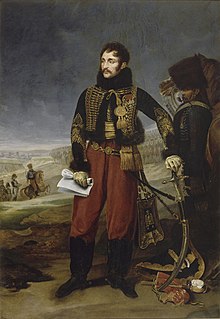Battle of Wischau
Appearance
| Battle of Wischau | |||||||
|---|---|---|---|---|---|---|---|
| Part of the War of the Third Coalition | |||||||
 Lasalle, by Antoine-Jean Gros (1808) | |||||||
| |||||||
| Belligerents | |||||||
|
|
| ||||||
| Commanders and leaders | |||||||
| Frédéric Henri Walther Antoine Charles Louis de Lasalle | Prince Pyotr Bagration | ||||||
| Strength | |||||||
| 1,400 | 24,000 | ||||||
| Casualties and losses | |||||||
| unclear, Imperial Eagle and Guidon (11th Dragoons) | unclear | ||||||
War of the Third Coalition:
Austria
Austria
current battle
Napoleon in command
Napoleon not in command
The Battle of Wischau occurred on 25 November 1805, between the Russian and French armies. The conflict resulted in a minor Russian success. It followed the action at Hollabrun and Schöngrabern, and preceded the Battle of Austerlitz. The relatively easy Russian victory convinced the Third Coalition Allies that the French army would be easy to beat, having reached the end of their supply and communication lines, and having suffered several losses in previous weeks of fighting.
Orders of Battle
French forces
- General of Division Frédéric Henri Walther
- Division of Reserve Cavalry
- General of Division Antoine Charles Louis de Lasalle
- Division of Lannes' V Corps
- 6th and 11th Dragoons (4 squadrons each)
- 9th and 10th Hussar Regiments (4 squadrons each), and
- 22nd Chasseurs Chevalier (4 squadrons)
- 12 guns
- Division of Lannes' V Corps
Total: 20 squadrons, 12 guns, approximately 1400 men.
11th Dragoons lost an Imperial Eagle and a guidon during the fight.
Russian forces
Advanced Guard
- Lieutenant General Bagration commanding
- Major Generals Dolgoruky, Ulanius, and Tschaplitz
- 6th Jägers (3 battalions)
- 9 battalions of the Infantry Regiments Alt-Ingermannland, Archangel, and Pskov
- Leib Kür Regiment (4 squadrons)
- Dragoon Regiment Twer (5 squadrons)
- Dragoon Regiment St. Petersburg (5 squadrons)
- Hussar Regiment Pavlograd (10 Squadrons
- Hussar Regiment Mariupol (10 squadrons)
- Cossacks (8 sotnia)
- 24 guns
- Major Generals Dolgoruky, Ulanius, and Tschaplitz
Total: 12 battalions, 35 squadrons, and 8 sotnias, 24 guns, approximately 12,000 men.
Sources
- Digby Smith. The Greenhill Napoleonic Wars Databook. London, Greenhill Books, 1998, p. 215.
External links
 Media related to Battle of Wischau at Wikimedia Commons
Media related to Battle of Wischau at Wikimedia Commons

